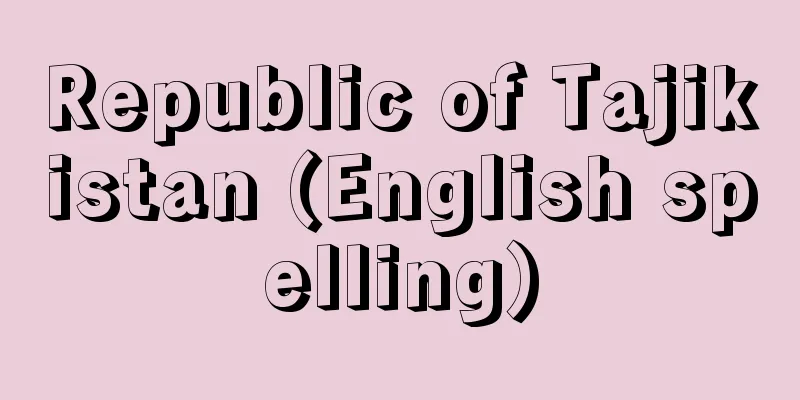Republic of Tajikistan (English spelling)

|
A republic located in Central Asia. Formerly one of the 15 republics that made up the Soviet Union, it was the Tajik Soviet Socialist Republic (Таджикская ССР/Tadzhikskaya SSR), but on September 9, 1991, just before the collapse of the Soviet Union (December 1991), it declared independence and adopted the traditional regional name and changed its name to the Republic of Tajikistan. It borders Afghanistan to the south, China to the east, and Uzbekistan and Kyrgyzstan to the west and north. It has an area of 143,100 square kilometers and a population of 6,992,000 (2006 estimate). The capital is Dushanbe, with a population of 553,000 (2007). [Shuji Yamashita and Hideaki Kimura] NatureThe eastern half of Tajikistan is the Pamir Plateau, the northwest is the Turkestan, Zerafshan, and Ghisar mountain ranges, the north is the western edge of the Fergana Basin, the southwest is the Bakhsh River and the Ghisar Valley, and the south is the right bank of the Amu Darya. As mentioned above, 90% of the country is mountainous. The Pamir Plateau is a high mountain area with an altitude of over 5,000 meters, and is well known to alpinists, with Komunizm Peak (7,495 meters) and Mount Lenin (7,134 meters). The main rivers are the Syr Darya and Zerafshan in the north, and the Amu Darya and its tributaries, the Bakhsh and Kafirnigan, in the south. The climate is extremely continental, with average temperatures around -2°C in January and 27°C to 30°C in July, and annual precipitation is on average 700 mm, but not even 100 mm in the east. Most of the country is desert or steppe (short grass steppe). [Shuji Yamashita and Hideaki Kimura] History and politicsBactria is the oldest state in Central Asia, which includes Tajikistan. This region was occupied by the Iranians in the 6th to 4th centuries BC, and was also ruled by the Greeks and Turks. It was conquered by the Arabs in the 8th century, and the Samanid dynasty established a great state in the 9th century. It was conquered by the Mongols in the 13th century, and most of it was annexed by the Bukhara Khanate in the 16th century. In 1868, Russia annexed Fergana, Samarkand, and other areas, making the Bukhara Khanate a protectorate. The establishment of the Soviet regime in Tashkent in November 1917 had a major impact on northern Tajikistan. The Emir of Bukhara (Khan) allied himself with the White Army led by Kolchak and Dutov, and the Basmachi movement, an anti-Soviet uprising by Muslim peasants, and continued to pursue a reactionary domestic and foreign policy, but in August 1920, an armed uprising in Charzhuy (now Turkmenabat) led the Red Army led by Frunze to enter the city, and in October the Bukhara People's Soviet Republic was established. This became a socialist republic in September 1924. In the same year, the ethnic borders of Central Asia were demarcated, and the Tajik Autonomous Republic was born as part of the Uzbek Republic, with part of the Bukharan Republic being included within it. In 1929, the Tajik Autonomous Republic was promoted to a federal republic, becoming the Tajik Soviet Socialist Republic. In August 1990, the Tajik Supreme Soviet adopted a declaration of sovereignty, becoming the Republic of Tajikistan. On September 9, 1991, it proclaimed independence and joined the Commonwealth of Independent States (CIS) in December. The Communist Party was strong in Tajikistan, and even after the August 1991 coup in the Soviet Union, the Communist Party continued to exert its influence, winning the presidential election on November 24th, when Communist Party leader Rakhman Nabiev (1930-1993) was elected. In 1992, the radical reformist Democratic Party and the Islamic Renaissance Party came together to form a coalition with the president, forcing Nabiev to resign in September, but the former Communist Party-affiliated Popular Front forces formed in the southern Kulyab Province recaptured the capital, Dushanbe, and in December established a government led by Supreme Council Chairman Rakhmonov (whose name was changed to Rahmon in April 2007), who had previously served as chairman of a sovkhoz (state-run farm). In response, Islamic forces attacked with the support of Afghan guerrillas, leading to a civil war that resulted in more than 500,000 refugees, or 10% of the total population, and Popular Front Chairman Safarov was killed at the end of March 1993. Rakhmonov was elected president on November 6, 1994, defeating Abdullahzhanov, who advocated private ownership and was supported by businessmen, and a new constitution was adopted in a national referendum held at the same time. Rebellions broke out within the government forces in protest of corruption, and in February 1996 the First Deputy Prime Minister and others were dismissed. Rakhmonov was re-elected in the November 1999 presidential election, and was re-elected for a third term in November 2006. In response to the civil war, Tajikistan signed a collective security treaty with Russia, Armenia, Uzbekistan, Kazakhstan, and Kyrgyzstan (now Kyrgyzstan) on May 15, 1992. On August 7, these four Central Asian countries and Russia held a summit and announced that they would jointly defend Tajikistan's border as the common border of the CIS based on the collective security treaty. The Russian military has deployed a joint CIS peacekeeping force of about 20,000 to 30,000 troops on the border, but fighting has been taking place between the Russian military and anti-government guerrillas. Since 1994, ceasefire talks have continued between the government and the anti-government, and a final peace agreement was signed in June 1997. After that, a constitutional amendment referendum was held in September 1999, a presidential election was held in November, and a parliamentary election was held in 2000, completing the peace process. The President serves a seven-year term. The parliament is bicameral, with the upper house (National Assembly) having 33 members and the lower house (Assembly of Representatives) having 63 members, both of which serve five-year terms. [Shuji Yamashita and Hideaki Kimura] Industry and EconomyThe inhabitants, who traditionally specialized in grazing sheep, goats, and yaks, are now cultivating grains, beets, and potatoes, as well as watermelons, apples, and pears on irrigated agricultural land (which accounts for 30% of the land area). Fine-fiber cotton is also cultivated in the foothills. Silk and cotton in the Fergana Basin and cotton in the Amu Darya basin are the most important crops. The food industry is winemaking and oil refining, with wine brewing in the north and oil refining in the south. The region is also a treasure trove of nonferrous and rare metals, and plans have been made to industrialize the foothills, with several hydroelectric power plants being built using the rapids. In particular, the Nurek Power Station, built by damming the Bakhsh River, has an output of 2.7 million kilowatts and provides sufficient light, heat, and power for factories and townspeople. Although industrial production is low, aluminum has been produced since the Soviet era and has been the core of the export industry. In foreign trade, Russia exports aluminum, cotton textiles, etc., and imports petroleum products, electricity, machinery and equipment, etc. Its per capita national income is the lowest among the CIS countries, and in 1995, an aid agreement was signed with Russia to avoid an economic crisis. In April 1993, Russia joined the International Monetary Fund (IMF). On May 15, 1995, the country introduced its own currency, the Tajik ruble, which was replaced by the somoni in 2000. [Shuji Yamashita and Hideaki Kimura] societyTajiks are the only ethnic group of Iranian origin among the Central Asian countries whose national names are given to them. In the 1989 census, 62.3% of the total population of 5.09 million were Tajiks, 23.5% were Uzbeks, and 7.6% were Russians (in 2007, the figures were 64.9% Tajiks, 25% Uzbeks, 3.5% Russians, etc.). In the capital, Dushanbe, Russians make up 32.4%. Russians live in the capital and in the northern city of Khujand (known as Leninabad in the Soviet era), making up more than 60% of industrial workers, and have been active in research, education, medical, and administrative sectors that require high qualifications. Only 3.5% of Russians know Tajik, the official language. There were 32,671 Germans and 9,701 Jews, but like the Russians, they migrated to Germany, Israel, etc. during the chaos, and it is believed that their numbers have now drastically decreased. The 1989 census found that there were 3.17 million Tajiks, but there are many more in Afghanistan, at 3.7 million, and they are inevitably involved in the civil war in this neighboring country in various ways. One characteristic of the Tajiks is that only 30% of them have Russian as a second language. Another notable characteristic is their high population growth rate, which is 32.6 per 1,000 people, compared to 1.7 for Ukrainians. The total population in 1940 was 1.515 million, so it has increased 3.4 times in 50 years. The average family size was 6.1 people. However, after the collapse of the Soviet Union, the population growth rate per 1,000 people fell to 19.9 due to the decline in the birth rate and the increase in the death rate since 1992 after the collapse of the Soviet Union. This is a common phenomenon in the CIS countries, and shows how the collapse of the Soviet Union and the policies of capitalism have had a major impact on people's lives. Almost the entire country of Tajikistan is mountainous, with the Gorno-Badakhshan Autonomous Region in the eastern part of the country. The Tajiks who live in the mountainous regions are strongly influenced by Islam. Agriculture is practiced in a few basins, but the Khujand Province and Kulyab Province in the southwest, where cotton is cultivated, are the main product of Tajikistan, are the bases of the Communist Party. School education (primary and secondary) is 11 years long, with compulsory education lasting 9 years from age 6. In addition to the official language, Tajik, Russian is also widely used. The majority of people are Sunni Muslims, but in the Pamir region there are also many Shiite Muslims. [Shuji Yamashita and Hideaki Kimura] "Development Strategies of Central Asian Countries" edited by Hashida Tan (2000, Keiso Shobo)" ▽ "Encyclopedia of Central Eurasia" edited by Komatsu Hisao, Umemura Tan et al. (2005, Heibonsha) ▽ "Going the Silk Road: Exploring Five Central Asian Countries" by Shimizu Yoko (2008, Toyo Shoten) [References] | | | | | | | | Mountains| | [Additional Resources] |"> Tajikistan flag ©Shogakukan Illustration/Shogakukan Creative "> Tajikistan Location Map Source: Shogakukan Encyclopedia Nipponica About Encyclopedia Nipponica Information | Legend |
|
中央アジアに位置する共和国。かつてはソビエト連邦を構成する15共和国の一つ、タジク・ソビエト社会主義共和国Таджикская ССР/Tadzhikskaya SSRであったが、ソ連崩壊(1991年12月)直前の1991年9月9日独立を宣言し、従来の地域名を採用してタジキスタン共和国と改称した。南はアフガニスタン、東は中国、西と北はウズベキスタン、キルギスに接する。面積14万3100平方キロメートル、人口699万2000(2006推計)。首都はドゥシャンベで、人口55万3000(2007)。 [山下脩二・木村英亮] 自然タジキスタンの東半はパミール高原、北西はトルキスタン、ゼラフシャン、ギッサールなどの山脈、北はフェルガナ盆地の西端、南西はバフシュ川とギッサールの谷、南はアムダリヤ右岸地域である。以上のように国土の90%は山地で占められている。パミール高原は標高5000メートルを超える高山地域で、コムニズム峰(7495メートル)やレーニン山(7134メートル)があり、アルピニストにはよく知られた地である。主要河川は北にシルダリヤ、ゼラフシャン、南にアムダリヤとその支流のバフシュ、カフィルニガンがある。気候は極端に大陸的で、平均気温は1月零下2℃前後、7月は27℃~30℃、年降水量は平均して700ミリメートル、東部では100ミリメートルにも達しない。大部分の地域は砂漠ないしステップ(短草草原)である。 [山下脩二・木村英亮] 歴史・政治タジキスタンを含む中央アジア最古の国家はバクトリアである。この地域は紀元前6~前4世紀にイラン人に占領され、さらにギリシア人、トルコ人によっても支配された。8世紀アラブに征服され、9世紀サーマーン朝が大国家を建設する。13世紀モンゴルが征服、16世紀ブハラ・ハン国がその大部分を併合する。ロシアは1868年、フェルガナ、サマルカンドなどを併合し、ブハラ・ハン国を保護国とした。1917年11月のタシケントにおけるソビエト政権の成立は、タジキスタン北部に大きな影響を及ぼした。ブハラ・エミール(汗)は、コルチャーク、ドゥートフなどの白軍やバスマチ運動とよばれるムスリム農民の反ソ暴動と結び、反動的な内外政策をとり続けたが、1920年8月、チャルジュイ(チャルジョウ、現トルクメナバード)での武装蜂起(ほうき)を機にフルンゼの率いる赤軍が入城し、10月ブハラ人民ソビエト共和国が成立した。これは1924年9月社会主義共和国となる。同年中央アジア民族的境界区分が行われてウズベク共和国の一部としてタジク自治共和国が誕生、ブハラ共和国の一部はそのなかに含まれることになった。タジク自治共和国は1929年に連邦構成共和国へ昇格、タジク・ソビエト社会主義共和国となった。 1990年8月タジク最高会議は主権国家宣言を採択、タジキスタン共和国となり、1991年9月9日独立を宣言、12月独立国家共同体(CIS)に加盟した。 タジキスタンでは共産党の勢力が強く、1991年のソ連における八月クーデター後も共産党勢力が攻勢をとり、11月24日の大統領選挙で共産党のナビエフRakhman Nabiev(1930―1993)を当選させた。1992年に急進改革派の民主党とイスラム再生党が結んで大統領に連立をのませ、9月にナビエフを辞任に追い込んだが、その後南部クリャブ州で結成された旧共産党系の人民戦線部隊が首都ドゥシャンベを取り戻し、12月にソフホーズ(国営農場)議長の経歴をもつ最高会議議長ラフモノフ(2007年4月ラフモンに改姓)の政府を樹立した。イスラム勢力はこれに対し、アフガニスタン・ゲリラの支援を得て攻撃したため内戦が続き、全人口の1割にも達する50万人以上の難民が発生、人民戦線議長サファロフも1993年3月末に殺害された。ラフモノフは1994年11月6日の大統領選挙で、私的所有を訴え企業家の支持を得たアブドラジャノフを破って当選し、同時に行われた国民投票で新憲法を採択した。政府軍のなかでも腐敗に抗議して反乱が起こり、1996年2月第一副首相などを解任した。ラフモノフは1999年11月の大統領選挙で再選、2006年11月には3選を果たした。 内戦に対応するため、タジキスタンはロシア、アルメニア、ウズベキスタン、カザフスタン、キルギスタン(現キルギス)と1992年5月15日に集団安全保障条約に調印したが、8月7日にはこの中央アジア4か国とロシアが首脳会議を開き、集団安全保障条約に基づいて、タジキスタンの国境をCIS共通の国境とみなし共同防衛することを声明した。ロシア軍は約2~3万人のCIS合同平和維持軍を国境に配置しているが、ロシア軍と反政府ゲリラの間で戦闘が行われていた。1994年以降、政府と反政府との間で停戦の話し合いが続けられ、1997年6月に最終的和平協定に調印した。その後、1999年9月の憲法改正国民投票、11月の大統領選挙を経て、2000年に議会選挙が行われ、和平プロセスが完了した。 大統領の任期は7年。議会は二院制で、議員定数は上院(国民議会)33、下院(代表者会議)63、任期はともに5年である。 [山下脩二・木村英亮] 産業・経済従来ヒツジ、ヤギ、ヤクの放牧を専業としてきた住民は、灌漑(かんがい)された農業用地(全土の30%を占める)で穀物、ビート(サトウダイコン)、ジャガイモの栽培や、スイカ、リンゴ、ナシの果樹栽培を行っている。山麓(さんろく)での細繊維種の綿花栽培も盛んである。フェルガナ盆地の絹、綿、アムダリヤ流域の綿はもっとも重要な作物となっている。食品工業はぶどう酒醸造と製油で、ぶどう酒は北部、製油は南部で盛んである。有色金属、希金属の宝庫でもあり、山麓地域の工業化が計画され、急流を利用していくつかの水力発電所も建設された。とりわけバフシュ川をせき止めてつくったヌレク発電所は出力270万キロワットで、工場や町村民に十分な照明、熱、動力を供給している。工業生産は少ないが、ソ連時代からアルミニウム生産が行われており、輸出産業の中心を占めてきた。対外貿易はアルミニウム、綿繊維などを輸出し、石油製品、電力、機械設備などを輸入している。1人当りの国民所得はCIS諸国のなかでも最低で、1995年には経済危機回避のため、ロシアとの間に援助協定が結ばれた。1993年4月には国際通貨基金(IMF)に加盟している。 1995年5月15日独自の通貨タジキスタン・ルーブルを導入、それが2000年よりソモニに変更となった。 [山下脩二・木村英亮] 社会タジク人は中央アジア諸国の国の名称を名のる民族のなかで唯一のイラン系民族である。1989年の人口調査では、総人口509万人のうちタジク人は62.3%、ウズベク人23.5%、ロシア人7.6%であった(2007年にはタジク人64.9%、ウズベク人25%、ロシア人3.5%などとなっている)。首都ドゥシャンベではロシア人が32.4%である。ロシア人は首都とその北の都市フジャント(ソ連時代の名称レニナバード)に住み、工業労働者の6割以上を占め、研究、教育、医療、管理部門など高い資格を求められる部門で活躍してきた。ロシア人で公用語であるタジク語を知っているものは3.5%にすぎない。ドイツ人は3万2671人、ユダヤ人は9701人であったが、ロシア人と同様、混乱のなかでドイツ、イスラエルなどに移住し、現在では激減しているものと思われる。 タジク人は1989年の人口調査で317万人であるが、アフガニスタンにはもっと多い370万人がおり、この隣国の内戦にさまざまなかたちでかかわらざるをえない。タジク人の一つの特徴は、第二言語としてロシア語を修得している者が3割と低いことである。もう一つの際だった特徴は人口の増加率が高いことで、1000人当り32.6、ウクライナ人の1.7と比べればその高さがわかる。1940年の総人口が151万5000人であったから50年間で3.4倍になったのである。1家族平均人数は6.1人であった。しかし、ソ連の解体後、1992年以降の出生率の低下と死亡率の増大のため、1000人当り人口の増加率は19.9へと減少した。これはCIS諸国共通の現象であるが、ソ連解体と資本主義化の政策が人々の生活にいかに大きな打撃を与えているかがわかる。 タジキスタンはほとんど全土が高山で、国内東側にゴルノ・バダフシャン自治州が設けられている。山岳地帯に住むタジク人にはイスラムの影響が強い。農耕はわずかな盆地で行われているが、おもな生産物である綿の栽培が盛んなフジャント州や南西部のクリヤブ州は共産党の基盤である。 学校教育(初等・中等)は11年制で、義務教育は6歳から9年間。公用語のタジク語のほかにロシア語も広く使われている。宗教はイスラム教スンニー派が多数を占めているが、パミール地方では同シーア派も多い。 [山下脩二・木村英亮] 『橋田担編『中央アジア諸国の開発戦略』(2000・勁草書房)』▽『小松久男・梅村担他編『中央ユーラシアを知る事典』(2005・平凡社)』▽『清水陽子著『シルクロードを行く――中央アジア五カ国探訪』(2008・東洋書店)』 [参照項目] | | | | | | | | | | [補完資料] |"> タジキスタンの国旗 ©Shogakukan 作図/小学館クリエイティブ"> タジキスタン位置図 出典 小学館 日本大百科全書(ニッポニカ)日本大百科全書(ニッポニカ)について 情報 | 凡例 |
<<: Tajik - Tajikgo (English spelling)
Recommend
Ashigawa [village] - Ashigawa
A village in Higashi-Yatsushiro County in the sout...
Lower rule -
The time when a planet is west of the Sun and its ...
Lumumba Peoples Friendship University (English name)
An institution of higher education established in ...
Atharvaveda
It is one of the Vedas, the sacred texts of ancien...
Buitenzorg
...Population: 272,000 (1990). Located about 60 k...
Pedobesia
…This was once called the sea egg Halicystis , bu...
Daimyo loan - Daimyo-gashi
In the Edo period, usurers would lend gold and si...
Agelenidae
…A general term for spiders in the Agelenidae fam...
Chronicles of the Three Generations of the Asai Family
This is a record of the rise and fall of the three...
Material industry/processing and assembly industry
Materials industries include industries such as st...
toga praetexta (English spelling) toga praetexta
...Women also wore togas in the early period, but...
Desiccated thyroid
...When the chemical nature of hormones was unkno...
Ethnocentrism
Ethnocentrism. A word derived from the Greek words...
Mr. Fukabori
A medieval and early modern samurai family from Ka...
Nanook of the North
...This first feature-length documentary film, wh...









